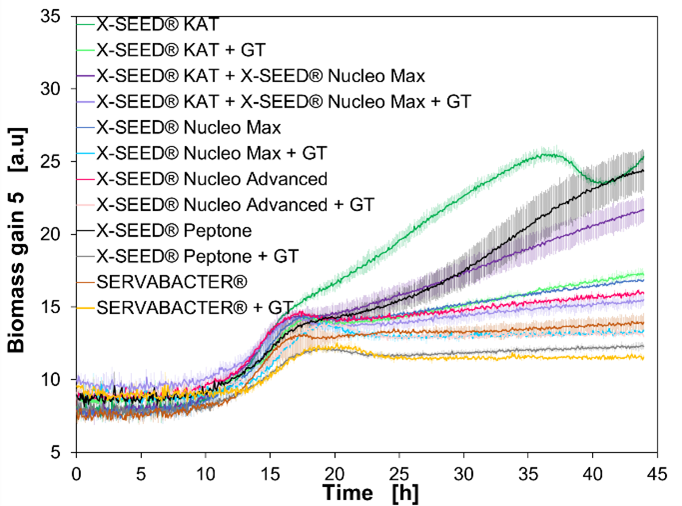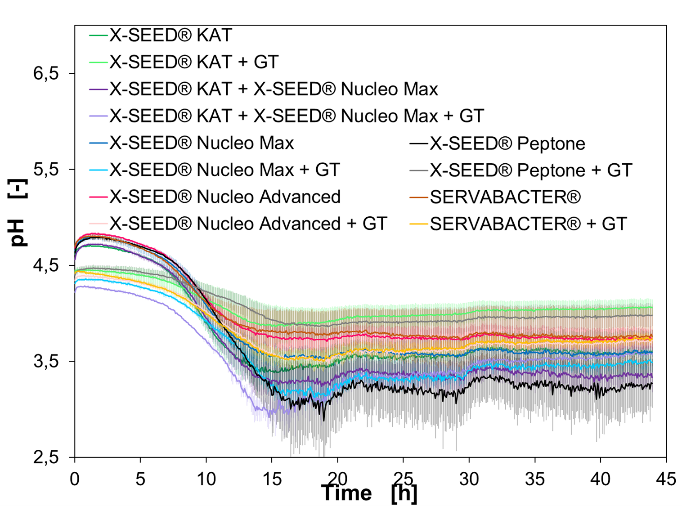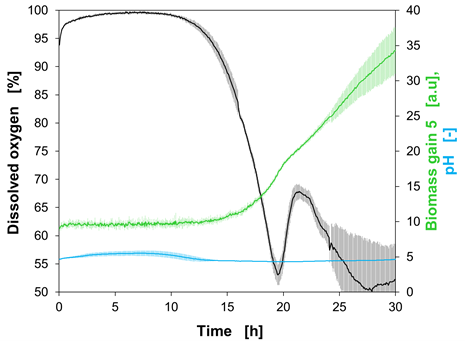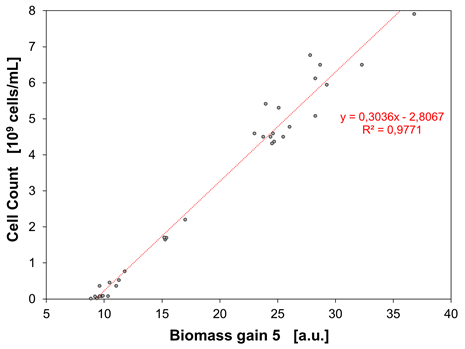Screening yeast extract to improve biomass production in acetic acid bacteria starter culture
Maximilian Schmacht1, Martin Senz1, Anna Korona2
1 Research Associate at Department BEAM of Research and Teaching Institute for Brewing in Berlin (VLB) [m.schmacht@vlb-berlin.org]
1 Head of Research Institute for Biotechnology and Water at Research and Teaching Institute for Brewing in Berlin (VLB) [m.senz@vlb-berlin.org]
2 Scientist at m2p-labs GmbH [Korona@m2p-labs.com]
Introduction
Over the past several years, the demand for naturally fermented drinks such as kombucha, kefir, water kefir and kwass, has grown significantly [1–3]. Traditionally, these sour fermented products are produced by undefined consortia of bacteria and/or yeast. This lack of definition of the consortia impedes industrial scale production due to variability in costs and concerns related to microbial stability and product degradation. Thus, application of defined ‘starter cultures’ helps mitigate some of these production concerns, particularly product stability and reproducibility.
In the case of kombucha, the microbial consortium known as SCOBY, (Symbiotic Culture Of Bacteria and Yeast), mainly consists of acetic acid bacteria (e.g. Acetobacter spp., Gluconobacter spp., Gluconacetobacter spp. and Komagataeibacter spp.) and yeast (e.g. Brettanomyces spp. andZygosaccharomyces spp.) as well as in some cases lactic acid bacteria [3]. Sweetened tea is used as a base and through fermentation becomes a refreshing beverage with relatively high market demand.
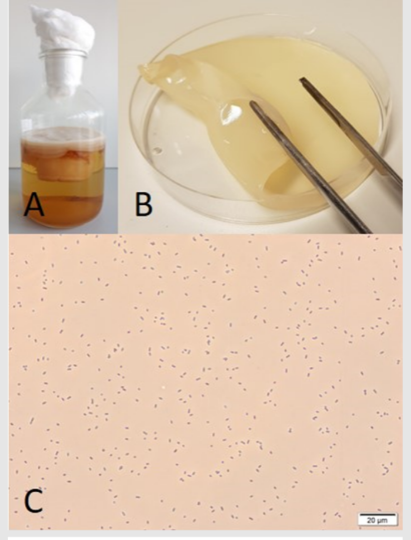
Figure 1: A: Kombucha traditionally fermented by a SCOBY. B:SCOBY consisting of exopolysaccharides and microorganisms. C: Microscopic image of the acetic acid bacterium Komagataeibacter hansenii Ko-0201.
Use of economically sourced complex media with the appropriate nutrient content is key for starter culture manufacturers to maximize productivity. There are different yeast extracts available which can cover the nutrient requirements of demanding microorganisms, by including
- high amounts of free amino acids,
- high amounts of peptones and/or
- high amounts of nucleotides.
The medium of choice is of course dependent on the strain(s) and culture conditions themselves. Thus, profitable biomass production necessitates screening experiments to define optimal process conditions.
In this study, we demonstrate that the BioLector® is a suitable device for online strain screening and for the investigation of the impact of different yeast extracts on biomass production of the acetic acid bacterium Komagataeibacter hansenii Ko-0201. Experiments were performed under controlled and uncontrolled pH conditions.
Methods
Cultivation strain: Komagataeibacter hansenii Ko-0201 was taken from the VLB strain collection.
Cultivation media: Yeast extract dextrose media were prepared consisting of 50g/L glucose and 10g/L of the respective yeast extracts:
- SERVABACTER®, Serva Electrophoresis GmbH; control batch
- X-SEED® KAT, Ohly GmbH; rich in free amino acids
- X-SEED® Nucleo Advanced, Ohly GmbH; rich in free ribonucleotides
- X-SEED® Nucleo Max, Ohly GmbH; further enriched in free ribonucleotides
- X-SEED® Peptone, Ohly GmbH; rich in small peptides
The pH was adjusted to 5.5 before sterilization via autoclaving. The respective media were also mixed in equal volumes with green tea (2g/L green tea leaves + 60g/L glucose) as an alternative medium for adaption to the later kombucha fermentation.
Cultivation conditions in the BioLector®: Two‑stage preculturing of the acetic acid bacterium was conducted in YED medium with SERVABACTER® as yeast extract in shake flasks at 30°C. From the second preculture, the main fermentations without pH control were started in a 48-well FlowerPlate® (MTP-48-BOH3) which allows a reliable and non‑invasive pH screening in the range between pH4 to 6. Furthermore, the pH is measured optically in the infrared spectrum, to reduce potential interference of background fluorescence in the culture medium. 1mL of the respective culture medium was inoculated to a cell density of 107cells/mL. The plate was shaken at 1400rpm and incubated at 30°C.
The microfluidic FlowerPlate® is the system of choice to control pH via the microfluidic chip technology. Low‑pH optodes (MTP-MF32- BOH3)measure the pH of the cultivation and feedback control from the Biolector® initiates modulation of pH to the set point via microfluidic channels in the bottom of the plate. For this application, 800µL of the respective culture medium were inoculated to a cell density of 107cells/mL. The microfluidic FlowerPlate® was shaken at 1200rpm and 30°C. pH was adjusted to be above 4.5 or 5.5, respectively, with 10% KOH. At certain points in time, samples were taken for offline measurements of pH via a pH meter (testo 206-pH2) and cell concentration via MultisizerTM 3 Coulter Counter.
Online measurements in the BioLector®: Biomass (ID 401), pH-51 (ID 424) and dissolved oxygen (DO) (ID 228) filter modules were used for online process monitoring.
Results
Yeast extract screening without pH control: In a first experiment, the biomass formation was assessed in media containing different yeast extracts with and without tea addition. It was revealed (figure 2) that the highest biomass after 44h of fermentation was achieved in YED medium with X-SEED® KAT (with 25.37a.u. or 5.52·109cells/mL) as well as X-SEED® Peptone (with 24.36a.u. or 4.42·109cells/mL) yeast extracts without tea addition. When using the tea enriched medium, X-SEED® KAT was superior to X-SEED® Peptone. This was also seen in the offline cell concentration measurements as shown in table 1. The lowest biomass values were achieved using SERVABACTER® with 13.94a.u. and 11.55a.u. (2.31·109 cells/mL and 1.75·109cells/mL) and X‑SEED® Nucleo Advanced yeast extracts with 15.96a.u. and 12.98a.u. (2.44·109cells/mL and 1.93·109cells/mL).
Figure 2: Online biomass signal of the batch cultivation of Komagataeibacter hansenii Ko-0201. Media contain different yeast extracts and green tea additions (GT), biological duplicates.
Table 1: Online and offline data for the evaluation of K.hansenii biomass outcome after 44h depending on the yeast extract used. Mean values of biological duplicates.
| Medium | Biomass [a.u.] | Cell concentration [cells/mL] |
| SERVABACTER® | 13.94 | 2.31∙109 |
| SERVABACTER® + green tea |
11.55 |
1.75∙109 |
| X-SEED® KAT | 25.37 |
5.52∙109 |
| X-SEED® KAT + green tea |
17.22 |
3.01∙109 |
| X-SEED® Nucleo Max |
16.88 |
2.77∙109 |
| X-SEED® Nucleo Max + green tea |
13.39 |
2.00∙109 |
| X-SEED® Nucleo Advanced9 |
15.96 |
2.44∙109 |
| X-SEED® Nucleo Advanced + green tea |
12.98 |
1.93∙109 |
| X-SEED® Peptone |
24.36 |
4.22∙109 |
| X-SEED® Peptone + green tea |
12.29 |
1.50∙109 |
| X-SEED® KAT + X-SEED® Nucleo Max |
21.67 |
4.22∙109 |
| X-SEED® KAT + X-SEED® Nucleo Max + green tea |
15.50 |
2.26∙109 |
The pH values measured online showed that the media were strongly acidified leading to final pH values clearly below 4 as presented in figure 3.
Consequently, in order to increase the biomass production efficiency, pH-controlled experiments were conducted applying X-SEED® KAT as the best performing yeast extract.
Figure 3: Online pH signal of the batch cultivation of Komagataeibacter hansenii Ko-0201. Media contain different yeast extracts and green tea additions (GT), biological duplicates.
Yeast extract screening at controlled pH: K.hansenii Ko-0201 was fermented in YED medium applying X-SEED® KAT as yeast extract at controlled pH of 5.5 or 4.5 after two hours or natural acidification, respectively. The experiments controlled at pH 4.5 dropped slightly earlier in DO compared to the ones at pH 5.5 as shown infigure 4 and figure 5. Moreover, higher biomass values were achieved at pH 4.5 after 30h of fermentation.
Figure 4: Cultivation of Komagataeibacter hansenii Ko-0201 in YED medium containing X-SEED® KAT as yeast extract at pH5.5. Due to sampling, the number of biological replicatesdecreases over time. There is a total number of 7 biological replicates up to 16h, 5 replicates from 16h to 24h and 3 replicates from 24h until the end of fermentation.
Figure 5: Cultivation of Komagataeibacter hansenii Ko-0201 in YED medium containing X-SEED® KAT as yeast extract at pH 4.5. Due to sampling, the number of biological replicates decreases over time. There is a total number of 7 biological replicates up to 16h, 5 replicates from 16h to 24h and 2 replicates from 24h until the end of fermentation.
The observation in the online biomass signal was also reflected by the offline measurements of the respective cell concentrations listed in Table 2: With a final biomass value of 34.55a.u. (or 7.2·109cells/mL) at pH4.5 compared to a final biomass value of 28.24a.u. (or 6.46·109 cells/mL) at pH5.5.
Table 2: Online and offline data for the evaluation of K.hansenii biomass outcome with X-SEED® KAT after 30h depending on the fermentation pH. Mean values of biological triplicates at pH 5.5 and duplicates at pH 4.5.
| Setting | Biomass [a.u.] | Cell concentration [cells/mL] |
| YED with X-SEED® KAT controlled at pH 5.5 | 28.24 |
6.46∙109 |
| YED with X-SEED® KAT controlled at pH 4.5 | 34.55 |
7.20∙109 |
The controlled and online measured pH values were in good accordance with offline measurements as presented in figure 6, underlining the suitability of the low pH optodes for acetic acid bacteria starter culture production.
In figure 7, the correlation between online and offline determination of biomass is shown.
Figure 6: Correlation between online and offline measurement of pH.
Figure 7: Correlation between online and offline determination of biomass.
To conclude, we achieved improved biomass production of K. hansenii Ko-0201 in X-SEED® KAT by controlling pH. Furthermore, the pH‑control in the low pH range between 4.5 and 5.5 was successful and a good correlation between online and offline values were achieved.
Conclusion
The choice of the right cultivation medium providing all essential nutrients for effective biomass production finally pays off in the production of starter cultures.
Here, a yeast extract screening for biomass production of the acetic acid bacterium Komagataeibacter hansenii Ko-0201 was conducted at rather low fermentation pH values. Thus, the microfluidic FlowerPlates® equipped with low pH optodes proved to be well suited to meet the demands of proper online pH measurement as well as pH control.
Applying X-SEED® KAT (Ohly GmbH, Germany) as yeast extract, which is enriched with free amino acids, high cell densities of K.hansenii of up to 7.20 109cells/mL in pH-controlled batch fermentations were achievable.
Acknowledgement
m2p-labs thanks the Department for Bioprocess Engineering and Applied Microbiology (BEAM) of Versuchs- und Lehranstalt für Brauerei Berlin (VLB) e.V. for the collaboration.
References
- Chakravorty, S.; Bhattacharya, S.; Bhattacharya, D.; Sarkar, S.; Gachhui, R. Kombucha: A Promising Functional Beverage Prepared From Tea. In Non-Alcoholic Beverages: Volume 6: The Science of Beverages; Grumezescu, A.M., Holban, A.N., Eds.; Elsevier, 2019; pp 285–327.
- Kapp, J.M.; Sumner, W. Kombucha: a systematic review of the empirical evidence of human health benefit. Annals of Epidemiology 2019, 30, 66–70, doi:10.1016/j.annepidem.2018.11.001.
- Laureys, D.; Britton, S.J.; Clippeleer, J. de. Kombucha Tea Fermentation: A Review. Journal of the American Society of Brewing Chemists 2020, 78, 165–174, doi:10.1080/03610470.2020.1734150.
Cover-Picture:
Picture showing the tea flask is taken from:https://www.istockphoto.com/de/fotos/kombucha?phrase=kombucha&sort=mostpopular, December, 2020.
Additional information
Please visit our websites for further information: www.m2p-labs.com, www.beckman.com and www.vlb-berlin.org/fibw/beam. For more information about X-SEED® KAT, please refer to www.ohly.com
Beckman Coulter, the stylized logo, and the Beckman Coulter product and service marks mentioned herein are trademarks or registered trademarks of Beckman Coulter, Inc. in the United States and other countries. m2p-labs and the stylized logo are trademarks and registered trademarks of m2p-labs GmbH in the United States and other countries. m2p-labs is a Beckman Coulter Company. All other trademarks are the property of their respective owners.

